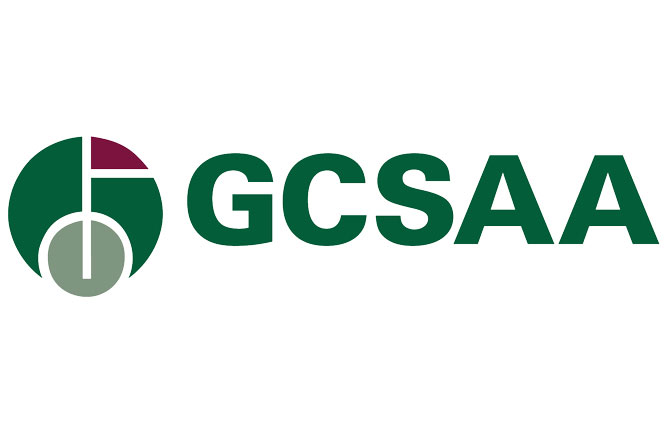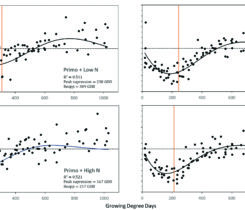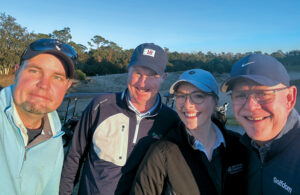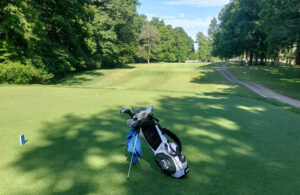Fungicide evaluations for dollar spot control on golf courses
We evaluated fungicide treatments for disease control at the William H. Daniel Turfgrass Research and Diagnostic Center at Purdue University in West Lafayette, Ind. We performed putting green trials on ‘Crenshaw’ and ‘Pennlinks’ creeping bentgrass putting greens.
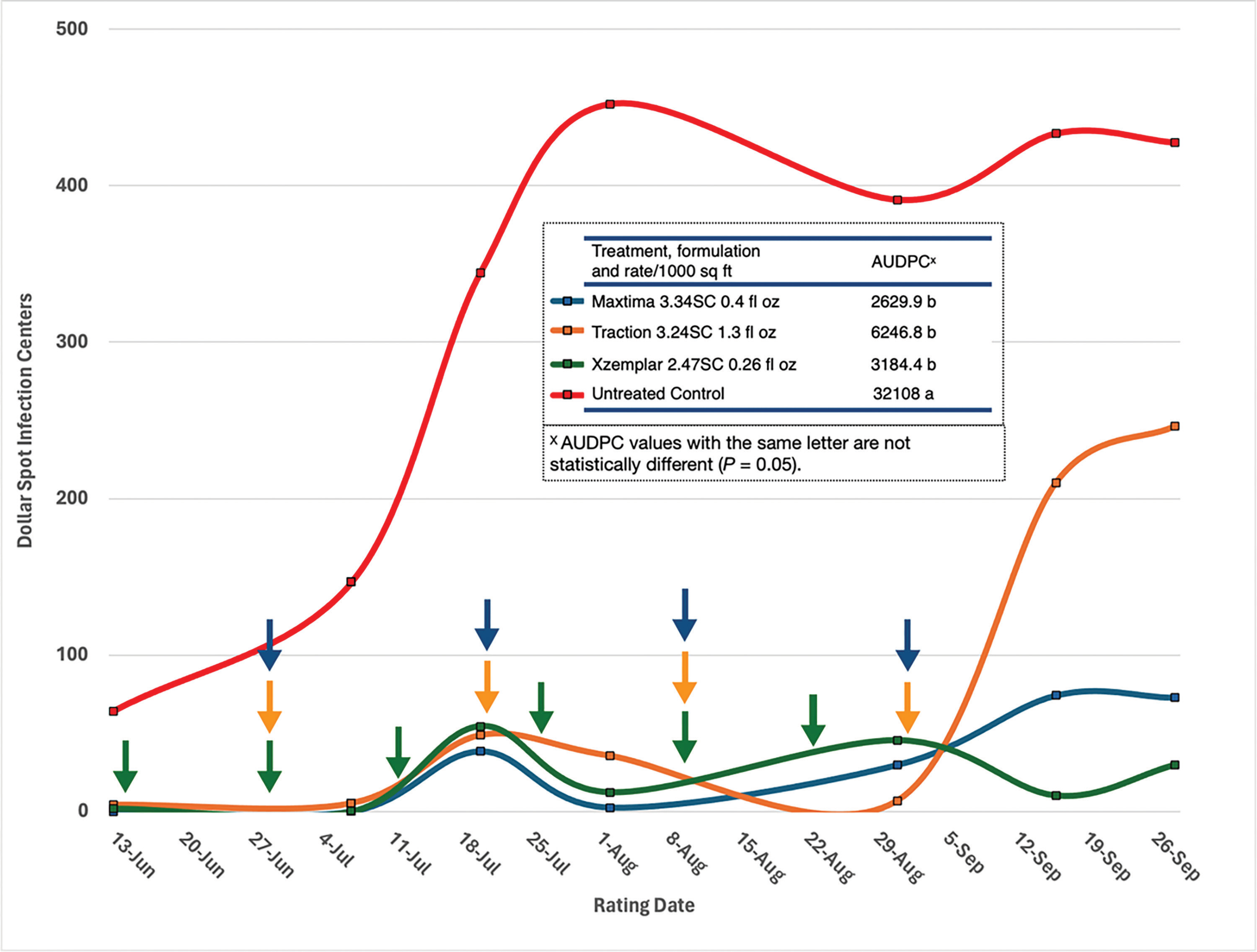
Figure 1: Fungicide treatments on a ‘Crenshaw’ creeping bentgrass putting green. Maxtima and Traction’s final applications were made on August 30, and Xzemplar’s final application was made on August 23. Arrows indicate application dates for each fungicide on 14 d (Xzemplar) and 21 d (Maxtima and Traction), respectively.
We mowed both greens five times weekly at a height of 0.135 inches from April 1 to Sept. 29, 2023. We applied to both greens the wetting agent Excalibur (Aqua-Aid Solutions) on June 9 and June 28 at a rate of 4 fl. oz./1000 ft. sq. and on July 20 at a rate of 2.7 fl. oz./1000 ft. sq. to limit the development of localized dry spot.
We then applied the wetting agent Fleet (2.7 fl. oz./1000 ft. sq.) to greens on August 16 to limit the development of localized dry spot.
We applied Tempo SC (cyfluthrin, Envu) at 9 fl. oz./acre and Meridian (thiamethoxam, Syngenta) at 12 fl. oz./acre on June 9 for ant control. We applied nitrogen using Country Club MD (18-3-18, LebanonTurf) on June 10 and September 2 at 0.5 lbs. N/1000 ft. sq.
Our trial plots were 5-by-5 ft and arranged in a randomized complete block design with four replications. Treatments were applied in water equivalent to 2 gal/1000 ft. sq. with a CO2-powered sprayer, at 50 psi using three TeeJet 8008 flat fan nozzles.
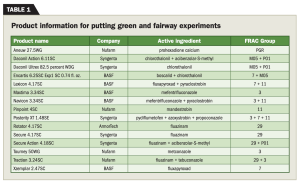 For both trials (Experiment 1 and Experiment 2), we initiated all treatments on May 17, with the last application varying according to treatment (Table 1). On July 1, using a hand-held broadcast spreader we applied a rye grain infested with the dollar spot pathogen uniformly at 12.5 cc per plot. We then left the rye grain on the turf surface for four days before mowing.
For both trials (Experiment 1 and Experiment 2), we initiated all treatments on May 17, with the last application varying according to treatment (Table 1). On July 1, using a hand-held broadcast spreader we applied a rye grain infested with the dollar spot pathogen uniformly at 12.5 cc per plot. We then left the rye grain on the turf surface for four days before mowing.
We assessed dollar spot severity as counts of infection centers per plot. The area under the disease progress curve (AUDPC) was calculated using the trapezoidal method with the formula Σ [(yi + yi+1)/2] [ti+1 − ti], where i = 1,2,3, … n-1, where yi is the rating, and ti is the time of the ith rating. Data were subjected to analysis of variance and means separation using Fisher’s protected LSD test (P=0.05).
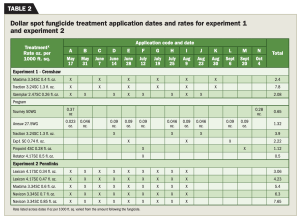 Experiment 1: Crenshaw Green
Experiment 1: Crenshaw Green
We first observed differences in dollar spot control among treated plots on May 31. On June 13, the program treatment plots had significantly higher dollar spot severity than other treatments (Figure 1). Conversely, the program had less dollar spot severity than other treatments on July 20.
On August 2, plots treated with Traction (fluazinam, tebuconazole, Nufarm) at 1.3 fl. oz./1000 ft. sq. – 21d had significantly more dollar spot than plots treated with Maxtima (mefentrifluconazole, BASF) at 0.4 fl. oz./1000 ft. sq. over the same period. On September 16 and 28, two and four weeks following the final application, respectively, plots treated with Traction had significantly more dollar spot than Maxtima and had significantly lower AUDPC values than the control.
Experiment 2: Pennlinks Green
We first saw dollar spot on July 7. All treated plots had less than one infection center per plot on July 7. There were no treatment differences throughout this experiment. All treated plots had significantly lower AUDPC values than the untreated control (Table 1).
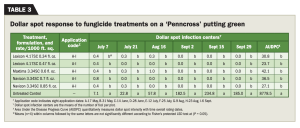 Fairway Experiment
Fairway Experiment
Fungicide treatments were evaluated for disease control at the Daniel Turfgrass Research and Diagnostic Center at Purdue on a mature ‘Independence’ creeping bentgrass fairway.
We mowed three times weekly at a height of 0.5 inches from April 1 to October 1. We applied Ference (cyantraniliprole, Syngenta) on June 30 at a rate of 0.37 fl. oz./1000 ft. sq. for white grub control. We used the wetting agent Excalibur on July 20 at a rate of 2.7 fl. oz./1000 ft. sq. to limit the development of localized dry spot.
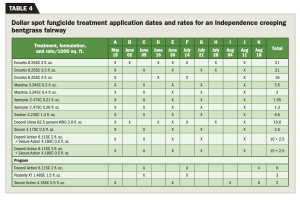 We applied the wetting agent Fleet (Harrell’s) on August 16 at a rate of 3 fl. oz./1000 ft. sq. to limit the development of localized dry spot. We then applied nitrogen using Shaw’s (24-0-22) on May 24 at 0.75 lbs. N/1000 ft. sq. and September 13 at 1.0 lbs. N/1000 ft. sq.
We applied the wetting agent Fleet (Harrell’s) on August 16 at a rate of 3 fl. oz./1000 ft. sq. to limit the development of localized dry spot. We then applied nitrogen using Shaw’s (24-0-22) on May 24 at 0.75 lbs. N/1000 ft. sq. and September 13 at 1.0 lbs. N/1000 ft. sq.
Plots were 5-by-5 ft. and arranged in a randomized complete block design with four replications. Treatments were applied in water equivalent to 1 gal/1000 ft. sq. with a CO2-powered sprayer at 45 psi using three TeeJet 8008 flat fan nozzles.
We made initial fungicide applications on May 19 and the last on August 18. We applied rye grain infested with the dollar spot pathogen uniformly with a hand-held broadcast spreader on June 27 and July 1 at 11 and 12 cc per plot, respectively. We then left rye grain on the turf surface for four days before mowing.
We assessed disease severity every two weeks throughout the study. Disease severity was evaluated as a visual estimate of the percent diseased area per plot. The area under the disease pressure curve (AUDPC) was calculated using the trapezoidal method mentioned above. Data were subjected to analysis of variance and means separation using Fisher’s protected LSD test (P=0.05).
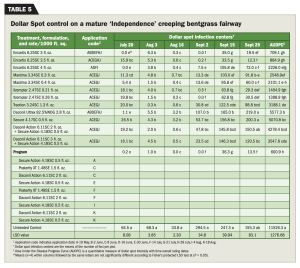 Fairway Results
Fairway Results
We first observed dollar spot on June 1 (<0.3 percent severity and 0.2 infection centers per plot) and increased following inoculation. On July 20, plots treated with Encartis (boscalid and chlorothalonil, BASF) at 3 fl. oz./1000 ft. sq. – 14 d and 4 fl. oz./1000 ft. sq. – 28 d, Daconil Ultrex (Chlorothalonil, Syngenta) at 2.8 fl oz/1000 ft. sq. – 14 d, and program treated plots had less dollar spot than all other treated plots and the untreated control.
From July 20 to September 15, all treated plots had fewer dollar spot infection centers than the untreated control. On September 2, two weeks following the final application (WFFA), plots treated with Encartis (3 fl. oz./1000 ft. sq. – 14 d), Encartis (3.5 fl. oz./1000 ft. sq. – 21 d), Xzemplar (fluxapyroxad, BASF) at 0.21 fl. oz./1000 ft. sq. – 21 day, Xzemplar (0.26 fl. oz./1000 ft. sq. – 21 day) and program treated plots had the lowest dollar spot severity.
On August 3 and August 16, Encartis rates and application timing did not significantly affect dollar spot control. However, on September 2 and September 15 (2 and 4 WFFA), plots treated more frequently with Encartis (3 fl. oz./1000 ft. sq. – 14 d) and Encartis (3.5 fl. oz./1000 ft. sq. – 21 d) had lower dollar spot severity than Encartis (4 fl. oz./1000 ft. sq. – 28 d).
Conversely, differences in application rate and timing within Xzemplar and Maxtima treatments did not significantly affect dollar spot severity during the study. The higher application rate of Daconil Action (3 fl. oz./1000 ft. sq.) mixed with Secure Action did not reduce dollar spot compared to the lower rate (2 fl. oz./1000 ft. sq.) Plots treated with Xzemplar had fewer dollar spot infection centers than Maxtima-treated plots on September 2.
AUDPC values for all treated plots were significantly lower than untreated control plots. The Program plots had consistently low dollar spot severity throughout the study, with the numerically lowest AUDPC value of all treatments.
Plots treated with Daconil Ultrex alone had a higher AUDPC value than all treated plots except those treated with Secure (fluazinam, Syngenta) at 0.5 fl. oz./1000 ft. sq. – 21 d) alone and Daconil Action (2 fl. oz./1000 ft. sq.) and Secure Action (acibenzolar-S-methyl and fluazinam, Syngenta) at 0.5 fl. oz./1000 ft. sq. – 21 d. No phytotoxicity was observed throughout the study.









